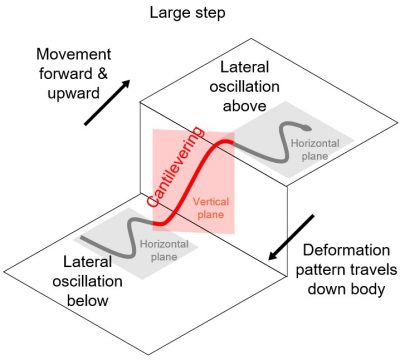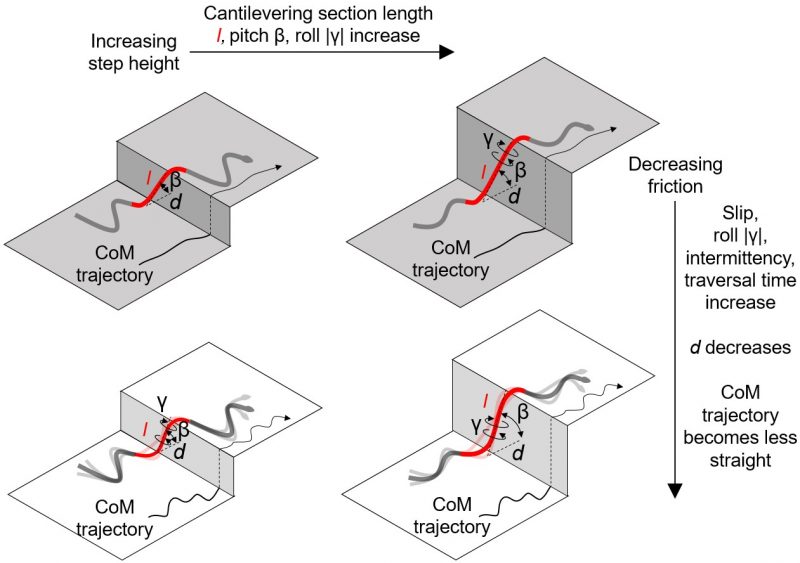Motivation
Many snakes live in deserts, forests, and river valleys and must traverse unstructured 3-D terrain like large rocks, felled trees, and rubble which are larger than themselves and have variable surface properties. Currently, our understanding of terrestrial snake locomotion has been relatively limited to that on flat surfaces, whether they are level, sloped, granular, scattered with peg arrays, or confined between channels. By studying how snakes traverse a large 3-D step obstacle, we are able to gain insight into how snakes can traverse such variable obstacles in their natural environment. We found that the snakes use body partitioning to traverse the large step obstacle and that may be generally useful for diverse, complex 3-D terrain.

Body Partitioning
Generalist snakes divide their body into sections, each using distinct movement patterns, to get over large step-like obstacles. Body sections below and above the step oscillated laterally on horizontal surfaces for propulsion, while the body section in between cantilevered in a vertical plane to bridge the large height increase. The snake’s partitioned gait, allows it to conform to the large step obstacle throughout traversal. Such partitioning of the body into sections, which serve different locomotor functions and are coordinated together to achieve high-level locomotor tasks, has also been observed in many arboreal snakes moving on branches or ledges.

Partitioning is conserved when terrain changes
The snake adjusted the partitioned gait in response to an increase in step height and a decrease in surface friction, at the cost of reduced speed. As surface friction decreased, body movement below and above the step changed from a continuous lateral undulation with little slip to an intermittent oscillatory movement with much slip, and initial head lift-off became closer to the step.

Benefits for stability
Body partitioning allowed the snake to be always stable, even when initially cantilevering but before reaching the surface above. To maintain stability, snakes use more irregular or asymmetric lateral movements for pitch roll stability due to the lack of large asperities for gripping that many tree snakes use when bridging gaps between branches. However, lateral movement to maintain stability means the snake sacrifices some of its ability to reach higher steps because it uses less of its body to cantilever.

Body partitioning is general
Although only shown here in one species of snake traversing a vertical step connecting two horizontal surfaces, a partitioned gait and the ability to adjust it in response to terrain variation may be a general locomotor adaption of generalist snakes to their diverse habitats consisting of complex 3-D terrain. We found evidence of this by observing that the kingsnake partitioned its body into many sections in a similar fashion (alternating between having surface contact and cantilevering) to traverse down a step, across a gap, and across uneven terrain.
Related publications
- Gart SW, Mitchel TW, *Li C (2019). Snakes partition their body to traverse large steps stably, Journal of Experimental Biology, 222, jeb185991 PDF
- Fu Q, Gart SW, Mitchel TW, Kim JS, Chirikjian GS, *Li C, Lateral Oscillation and Body Compliance Help Snakes and Snake Robots Stably Traverse Large, Smooth Obstacles, Integrative & Comparative Biology, icaa013, PDF (Invited Paper) Video
